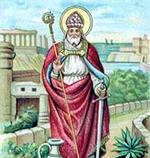Catholic World News News Feature
The Pope's long physical decline April 01, 2005
At a midday press briefing on April 1, Joaquin Navarro-Valls, the director of the Vatican press office, essentially confirmed that Pope John Paul II is facing his final struggle after a long series of health problems.
Despite persistent speculation about his possible retirement, which flourished for the last several years of his long 26-year pontificate, John Paul II will have completed his own goal, persevering as leader of the Church until his death.
In the fall of 2003, when the Holy Father went through a severe health crisis, the talk of papal retirement reached a crescendo. But on that occasion-- as on many others-- John Paul II showed his resilience, recovering his health and resuming his regular work.
Since 2002, the Pope has been restricted in his physical movements, using a rolling chair (not a wheelchair, but an armchair secured on a platform equipped with wheels) to move around the Vatican. But until February of this year he continued to hold his regular public audiences.
It was in February 2002 that the Pope's physical ailments first began to require significant changes in his schedule. After the annual Lenten Retreat at the Vatican that year, the press office announced that John Paul II would discontinue his practice of visiting parishes in the Rome diocese. At the time, that change was attributed to "arthritic" problems. The Vatican was not ready to admit that the Holy Father suffered from Parkinson's disease. In fact, although that ailment is now universally recognized, it has never been formally acknowledged by the Vatican.
Also in 2002, most of the Pope's private audiences were moved to his apartments on the third floor of the apostolic palace, rather than the more formal rooms on the second floor. And during public liturgical celebrations, the Holy Father began to remain seating for most of the events; he would "preside" rather than acting as principal celebrant of the Mass.
The Pope's physical weakness became evident to the public in May 2002, during a pastoral trip to Azerbaidjan and Bulgaria. For the first time, organizers of the papal trip made special provisions to accommodate his restricted mobility, bringing a moving platform to transport him, and an elevator to help him on and off the airplane.
The year 2003 saw both improvement and deterioration in the Pope's health. He was able to make a long trans-Atlantic trip to Canada and Central America, but during a visit to Slovakia in September he appeared to be in very severe condition, and observers felt his life was in imminent danger. In October, as the world's cardinals gathered for a consistory, there was open discussion about the possibility that they would soon meet again in a papal conclave. But by December the Pope had rallied, resuming his public appearances.
Although there was a near-universal agreement that the trip to Slovakia would be his last venture abroad, John Paul Ii traveled to Switzerland in June 2004, then made a Marian pilgrimage to Lourdes in August. He also traveled to Loretto, Italy, in September 2004-- his last trip outside Rome. Since last late year, the Pope has curtailed his public activities still more. He presided at Christmas Mass, but did not attempt the traditional ordination of new bishops, or Baptism of infants, in early January.
During the early weeks of 2005, there have been relatively few major ceremonies at the Vatican, and there have been no plans made for papal travel abroad except a projected visit to Cologne, Germany, for World Youth Day in August.
On February 1, the Vatican press office announced that all papal audiences would be suspended, explaining that the Pope was suffering from the flu. But within 24 hours, John Paul was hospitalized with acute respiratory problems. Although he returned to the Vatican on February 10, he was unable to participate directly in the Lenten Retreat, for the first time in his 26-year pontificate, and on February 24 he was hospitalized once again. Doctors at Gemelli Hospital performed a tracheotomy to assist his breathing.
He returned to the Vatican once again for Holy Week, but could not participate in the liturgical celebrations-- appearing only a few times, by video-conference, from his apartment. On Easter Sunday he did make a public appearance to deliver his Urbi et Orbi blessing, but struggled in vain to speak, and appeared to be in obvious pain.
Finally, on March 31, Joaquin Navarro-Valls disclosed that the Pope was suffering from a high fever, brought on by an infection of his urinary tract. This was followed by a drop in blood pressure, and heart failure, precipitating what appeared to be a final crisis. The Pope's declining health has been a topic of keen public interest for years-- since May 13, 1981, when an assassination attempt first endangered his life. By May 2001, as Parkinson's disease robbed him of the physical vigor that he had displayed earlier in his pontificate, Navarro-Valls remarked that "the fatigue of John Paul II had become an element of his ministry."
Colleagues observed that the Holy Father had made a conscious decision to allow the public to observe his suffering, remaining in public view as his health declined.






